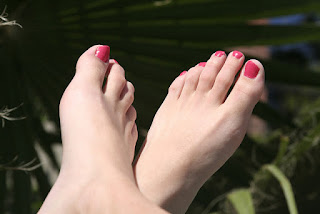There are many things that you can do to help avoid foot
problems down the road. Here are a few good tips on some easy ways to care for
your feet.
Good Circulation
Many things can reduce the flow of blood to the feet. Try
to avoid the following:
- Extended exposure to cold temperatures or cold water
- Shoes or socks that are too tight
- Sitting for long periods of time
- Smoking
If you are going to be sitting for an extended period,
take breaks and stand up. Stretching and walking promote good circulation.
Comfortable Shoes
Shoes that fit well can help to prevent many foot
problems. Beware of the following:
- Foot width can increase with age
- Lower heels are less damaging than high heels
- Thicker soles lessen pressure on hard surfaces
- The upper part of shoes should be flexible
Good shoes can help to avoid problems such as corns, calluses and bunions.
Proper Grooming
Keeping feet properly groomed can help to avoid many
problems.
- Cut toenails straight across and level with the top of the toe. This will help to avoid ingrown toenails.
- Keep feet dry and clean, especially between the toes. This will help to avoid bacterial and fungal infections.
- Use a mild soap and a moisturizer every day. This will help to avoid dry skin which can cause itchy burning feet.
If a problem with the foot does pop up, it is best to get
it treated right away. Your physician will let you know if and how the problem
can be prevented in the future.
Image by Amy the Nurse. My Feet! (2008). Flickr.



